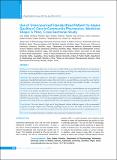Please use this identifier to cite or link to this item:
https://hdl.handle.net/20.500.14356/917| Title: | Use of Unannounced Standardized Patient to Assess Quality of Care in Community Pharmacies / Medicine Shops: A Pilot, Cross-Sectional Study |
| Authors: | Shrestha, Sony Shakya Koju, Pramesh Shrestha, Shreena Shrestha, Rojeena Koju Shahukhal, Suman Shrestha, Dipesh Shrestha, Rajeev Xu, Dong (Roman) Cai, Yiyuan Zhou, Jifang |
| Citation: | Shakya ShresthaS., KojuP., ShresthaS., Koju ShresthaR., ShahukhalS., ShresthaD., ShresthaR., XuD. (., CaiY., & ZhouJ. (2022). Use of Unannounced Standardized Patient to Assess Quality of Care in Community Pharmacies / Medicine Shops: A Pilot, Cross-Sectional Study. Journal of Nepal Health Research Council, 20(02), 524-533. https://doi.org/10.33314/jnhrc.v20i02.4294 |
| Issue Date: | 2022 |
| Publisher: | Nepal Health Research Council |
| Keywords: | Community Pharmacies Simulated visits Unannounced standardized patients |
| Series/Report no.: | April-June, 2022;4294 |
| Abstract: | Abstract Background: Community pharmacies are the most accessible healthcare providers l which plays a key role in primary healthcare services managing minor ailment and ensure the quality use of drugs. Our study aimed to assess the quality care from community pharmacies using unannounced standardized patient. Methods: All community pharmacies from three municipalities of Kavrepalanchowk district were visited by unannounced standardized patients presenting with acute dysentery, seasonal influenza, acute gastritis, acute diarrhea and pulmonary tuberculosis. Responses were audio-recorded and checked using standard checklist. Descriptive analysis was performed and data were presented as frequencies and percentages. Results: A total of 40 visits were performed for each case of acute dysentery, seasonal influenza and acute gastritis and 41 visits for acute diarrhea and pulmonary tuberculosis. During visits, on average, 17.7% (±12.3) of recommended questions were asked by the community pharmacies. Among the drug dispensed, on average, 1.9 (± 0.6) drugs were dispensed. All the community pharmacies 40 (100.0%) provided correct drugs in acute gastritis followed by 34 (85.0%) in acute dysentery, 31 (77.5%) in acute diarrhea and 21 (52.5) in seasonal influenza, whereas no pharmacies provided correct drug in the case of pulmonary TB. None of the pharmacies counseled on potential adverse effects. Conclusions: The study showed a high rate of drug dispensed without sufficient inquiry of the recommended symptoms for proper diagnosis and counseling regarding drug use was low. The study recommends a need for continuous training by concerned bodies to improve the quality of professional practice in the community pharmacies. Keywords: Community Pharmacies; simulated visits; unannounced standardized patients |
| Description: | Original Article |
| URI: | http://103.69.126.140:8080/handle/20.500.14356/917 |
| ISSN: | Print ISSN: 1727-5482; Online ISSN: 1999-6217 |
| Appears in Collections: | Vol 20 No 02 Issue 55 April-June, 2022 |
Files in This Item:
| File | Description | Size | Format | |
|---|---|---|---|---|
| 4294-Manuscript-29711-1-10-20221103.pdf | Full Article. | 349.66 kB | Adobe PDF |  View/Open |
Items in DSpace are protected by copyright, with all rights reserved, unless otherwise indicated.
